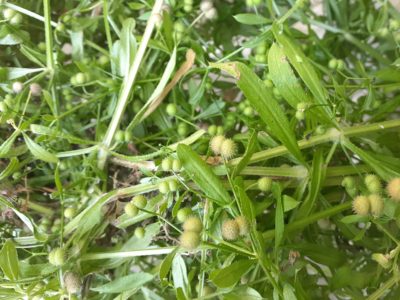This is the plant that leaves little round stickers on your shoes, socks, and pant legs, thanks to cleavers’ velcro-like texture. Cleaver seeds don’t do any damage to soft items, but all parts of them are tenaciously sticky. (Compare their harmless nature to the goatheads/puncturevine I’ve seen in Eastern Washington, which will stick to and puncture tires.)
I had read several plant identification pages and books that mentioned roasting the seeds for a coffee-like beverage (without much explanation). Then I saw an Instagram reel by @blackforager Alexis Nicole Nelson. She shared that cleavers are related to coffee (they’re in the same family, Rubiaceae) and that she enjoyed the flavor of the cleaver coffee she made (which was the color of a very light tea).
I had to give making cleaver coffee a try, but if I was going to enjoy it, I wanted this drink to be strong and dark, genuinely more like coffee. Here’s what I did, inspired by Alexis’ video to follow a similar method.

Common name(s): cleavers, bedstraw, scratch bedstraw, catchweed, sticky willy, stickyweed, hitchhikers, and many more!
Scientific name(s): Galium aparine
Origin: found in many locations around the world, cleavers are either naturalized in or native to North America.
Making Cleaver Coffee
The first time I made cleaver coffee, I picked all the seeds off of a couple of small vines, making only maybe a tablespoon of seeds. Then I roasted them in a non-stick saucepan, where they stayed green for ages and then suddenly burned about 15-20 minutes into the exercise.
Then I crushed the seeds with the back of a spoon and put them in maybe 4 oz of hot water. It made a vaguely brownish liquid that, at best, just tasted like burned water.
I suspected a few problems:
- Not enough cleaver seeds/Too much water
- Burned the seeds
- Didn’t grind the seeds finely enough to get a good steeping
I tried again later with a huge bush of cleavers I found growing in my backyard. I picked about 1/4 cup of seeds from those sticky vines. This was a long process, to be honest, as the seeds are small, not that prolific, and want to stick to everything. It probably took an hour to do this.
Then I sloooooooooooowly roasted the seeds in a non-stick pan over about 45 minutes so they became evenly but not dark brown. I ground them into powder using a mortar and pestle, and put 2 tablespoons of the powder into a fine-mesh tea strainer. I left the strainer in 8 ounces of water for 10 minutes.
This attempt tasted better – it tasted like strong roasted water, much more like tea than coffee. Adding milk and sugar didn’t really make the flavor more coffee-like.





Does anyone else who says “cleavers can make a coffee substitute” in their books or webpages actually try to do it themselves? Alexis is the real winner here for trying and inspiring me to try, and I’m glad she enjoyed it. For me, it was not worth the hour I spent picking seeds, or the 45 minutes I spent roasting them. A fun experiment, but one I won’t repeat. Would you try this? Let me know on Instagram!
This experiment also made me wary of analogies between plants based on them being in the same plant family. Cleavers are in the same family as coffee, sure, and they even have paired seeds, like coffee beans are paired. But that plant family, Rubiaceae, also includes the cinchona tree (from which we get quinine, the bitter agent in tonic water), gardenia flowers, and 13,500 other species. (Rubiaceae is one of the largest plant families in the world.)
Other Uses for Cleavers
Cleaver tinctures and teas are said to help with lymphatic issues in the body. I am not knowledgeable on this subject, so encourage you to look elsewhere if that interests you.
I just like to pick a few leaves to snack on during my walks. The flavor is very mild, and the texture is just fun to chew on (your mileage may vary).
Identification Notes
In the Pacific Northwest urban environment, I haven’t run into anything else remotely close to cleavers. A vine of cleavers has multiple leaf nodes of opposite somewhat-oval leaves, usually 3-6 leaves per leaf node. Every part of cleavers has a velcro-like surface texture when touched, when tasted, and when applied to any surface it can stick to, including itself. Cleavers have both single and paired seeds, as the above photo shows.
Cleavers often grow in disturbed soils in sunny areas, but they thrive in many different environments.
